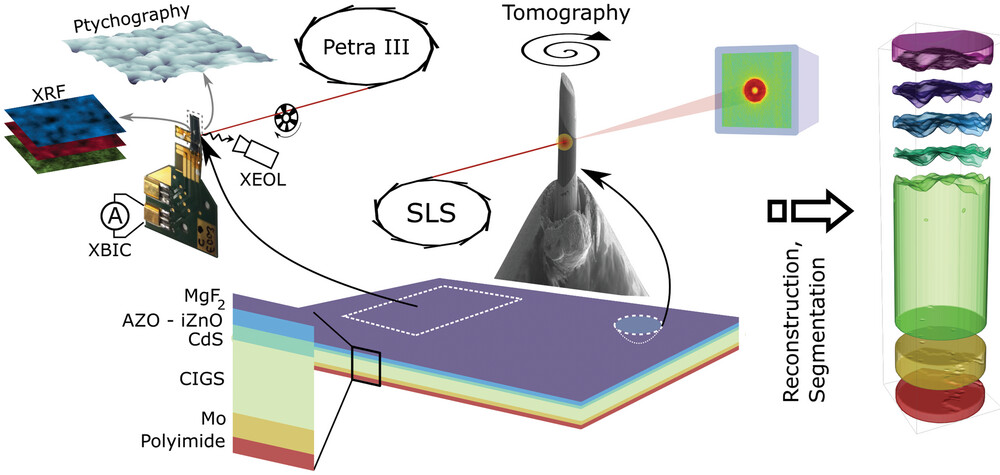| Dec 21, 2023 |
|
(Nanowerk News) An international team of researchers led by DESY has been investigating the correlation between defects in the material and the power generated by a solar cell, at an unprecedented resolution. The team used a range of experimental techniques to obtain its surprising results, which it has now published in the journal Advanced Science (“3D and Multimodal X-Ray Microscopy Reveals the Impact of Voids in CIGS Solar Cells”): defects, which inevitably arise when manufacturing so-called CIGS cells, can reduce their power output, but the effect is much less common and much more localised than expected.
|
 |
| Experimental concept. Two samples of the same layer stack are prepared for two different experiments. In the first experiment, a sample is mounted on a printed circuit board and electrically contacted so that maps of the induced current can be measured. In the second experiment, the sample is carved out and mounted on a pin, where it is molded to a cylindrical shape. Projections from different angles are acquired to yield a 3D reconstruction that can be processed and decomposed into individual layers. (©Advanced Science)
|
|
CIGS cells essentially consist of copper, indium, gallium and selenium, which are applied in a thin layer that is only around two thousandths of a millimetre thick. This thinness not only helps to conserve resources; unlike conventional crystalline solar cells, CIGS cells are also flexible, making them suitable for a wide range of applications.
|
|
The problem is that as CIGS cells are being manufactured, usually by vapour deposition of several different layers on a substrate, small regions known as voids form in the electricity-generating absorber layer, which might affect the power generation of the cell. The research team has now investigated this relationship in detail.
|
|
Using ptychographic and tomographic techniques, the researchers created a three-dimensional image showing where the production-related voids are located in the cell and how they are aligned. They did this by cutting a cylinder just a few micrometres across out of the solar cell at the Technical University of Denmark and examining it using synchrotron radiation produced by the SLS accelerator at the Paul Scherrer Institute in Switzerland.
|
|
“The voids mainly occur at the boundaries between adjacent crystal domains,” says DESY’s Michael Stuckelberger, co-author of the study, summarising their findings. “They all lie close to the surface and are generally aligned perpendicular to it. We were also able to determine that they are arranged in a superstructure, a kind of 3D network.”
|
|
The authors hope that their findings will be incorporated into the production process at the manufacturer Empa in Switzerland, to further reduce the harmful effect of the voids, ultimately increasing the efficiency of the solar cells.
|
|
The team then used the P06 beamline of DESY’s high-performance X-ray source PETRA III to analyse how much electricity is generated in exactly which areas of the solar cell. At the same time, they were able to analyse the local chemical composition of the sample using X-ray fluorescence – again collecting this data at the highest spatial resolution.
|
|
By combining all this information, the researchers were then able to come to a surprising and encouraging conclusion: “If electricity generation is reduced, then this actually occurs in the immediate vicinity of the voids,” says Stuckelberger. “However, we also saw that most of the voids had hardly any impact on the cell’s power production.”
|
|
Nevertheless, the researchers also realised that the X-ray sources available today limit their ability to study nanoscale defects in solar cells and draw systematic conclusions about how they work. The group hopes that the greater brightness and higher resolution of new light sources, such as PETRA IV, will further improve the explanatory power of their experiments.
|
- SEO Powered Content & PR Distribution. Get Amplified Today.
- PlatoData.Network Vertical Generative Ai. Empower Yourself. Access Here.
- PlatoAiStream. Web3 Intelligence. Knowledge Amplified. Access Here.
- PlatoESG. Carbon, CleanTech, Energy, Environment, Solar, Waste Management. Access Here.
- PlatoHealth. Biotech and Clinical Trials Intelligence. Access Here.
- Source: https://www.nanowerk.com/nanotechnology-news3/newsid=64296.php




